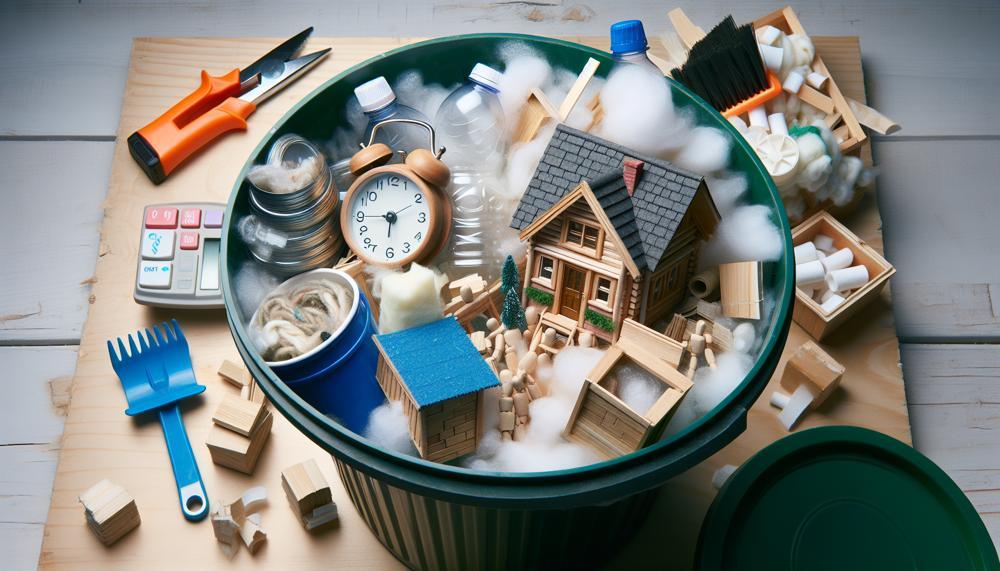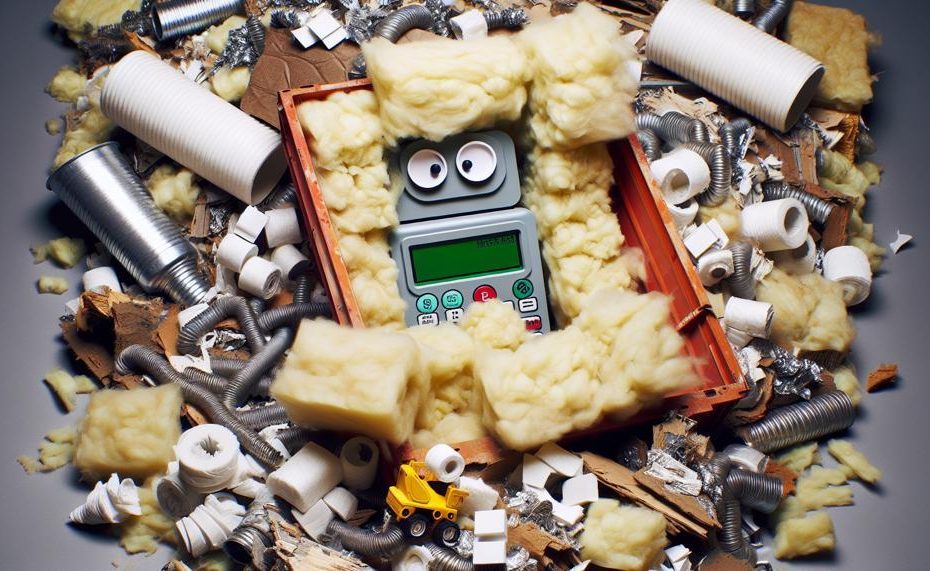When we think of recycling, images of plastic bottles and paper products may spring to mind, but what about the insulation in our homes and buildings? This essential material plays a crucial role in keeping us warm in the winter and cool in the summer, but it also has a significant impact on the environment.
Did you know that over 15% of landfill waste is composed of construction materials, including insulation? That’s right – despite its importance, insulation is often discarded without a second thought. And here’s another startling fact: traditional insulation materials such as fiberglass and foam can take hundreds of years to decompose. That means they will be sitting in landfills for generations to come.
Recycling insulation not only reduces waste but also conserves energy and resources. By repurposing this valuable material, we can prevent it from ending up in landfills and instead give it new life. With growing concerns about climate change, finding sustainable solutions for all aspects of our lives is more important than ever.
In this post, we’ll delve into the benefits of recycling insulation and how it can make a positive impact on both our environment and our wallets.
So, let’s dive in.
Contents
Key Takeaways
- It is crucial to properly dispose of insulation for the sake of both the environment and personal safety.
- Different types of insulation require specific methods of disposal.
- Eco-conscious options made from recycled or natural materials are gaining popularity.
- Researching local recycling programs can help in finding eco-friendly ways to dispose of insulation.
- Before disposing of old insulation, consider donating or finding alternative uses for it.
- Professional removal services are a safe and efficient solution for handling and disposing of insulation waste.
- Regular trash or recycling bins should not be used to dispose of insulation.
- Handling insulation can pose health risks such as skin, respiratory, and eye irritation.
- Even hazardous insulation materials can be recycled through specialized facilities while following safety protocols.
- Old insulation can be repurposed in various ways, such as soundproofing or creating garden beds.
- It is important to test for asbestos in old insulation before attempting to dispose of it.
Understand the Types of Insulation Materials
Insulation materials play a crucial role in keeping buildings comfortable and energy-efficient. However, when it comes to disposal, improper methods can lead to harmful environmental impacts. That’s why it’s important to understand the types of insulation materials that can be recycled or repurposed for a greener and more sustainable approach.
Fiberglass, made from recycled glass and sand, is one of the most widely recyclable insulation materials. Its versatile properties make it possible to be reused in various products like new insulation, carpeting, clothing, and even bottles.
Rock wool, on the other hand, is primarily made from recycled slag materials from the steel industry. This makes it highly accepted by recycling centers. The material can either be processed into new insulation products or used as a soil amendment for gardening purposes.
Cellulose insulation is another popular choice, primarily made from recycled newsprint and other paper materials. However, its fire-retardant treatment can make recycling a bit trickier. Nevertheless, some recycling facilities have developed processes to remove these chemicals and recycle the remaining material.
Finally, polyester fibers, thermally strengthened at high temperatures, are commonly used for thermal and sound insulation in buildings. This material boasts high recyclability and can be repurposed to create new insulation products or other items like textiles and plastic.
Research Local Recycling Programs
Local recycling programs commonly accept various types of insulation materials for recycling, including fiberglass, rock wool, cellulose, and polyester fibers.
These materials are typically used for thermal and sound insulation in buildings and can be repurposed into new products to reduce waste and conserve resources.
To provide a more comprehensive overview, the following table summarises the most common types of insulation that can be recycled through local recycling programs:
| Type of Insulation | Recyclable Materials | Common Uses |
| Fiberglass | Glass fibers | Thermal and sound insulation for buildings |
| Rock Wool | Stone wool fibers | Insulation for industrial, commercial, and residential buildings |
| Cellulose Insulation | Recycled newsprint and fire-retardant materials | Thermal insulation for attics, walls, and ceilings |
| Polyester Fibers | Thermally strengthened polyester fibers at 70°C | Thermal and sound insulation for roofs, attics, ceilings, and walls |
| Foam Board and Rigid Foam | Polyurethane foam boards or polystyrene foam panels | Insulation for walls, floors, roofs, and foundations |
Local recycling programs may also accept other types of insulation materials such as foam board and rigid foam. It is important to check with your local program to see which materials they accept for recycling.
Recycling these materials not only helps reduce waste but also has significant environmental benefits. For instance, using recycled fiberglass instead of virgin materials can save up to 64% of the energy needed for production. Moreover, recycling one ton of cellulose insulation can save up to 3.9 barrels of oil.
If you are uncertain about how to properly dispose of your old insulation, reach out to your local recycling program for guidance. By recycling these materials, you can play a role in creating a more sustainable and eco-friendly future.
Donate or Reuse Insulation
There are many ways to donate or reuse insulation, which can have a significant positive impact on the environment. Instead of simply discarding old insulation, here are some options to consider:
- Make a donation to Habitat for Humanity: A non-profit organization that builds affordable homes for families in need, Habitat for Humanity accepts donations of various building materials, including insulation, which can be utilized in their construction projects.
- Repurpose as a noise barrier: Old insulation can also be repurposed as a sound barrier in your home or office. This can be especially helpful if you live near a busy street or have loud neighbors.
- Utilize as animal bedding: For those with small pets like hamsters, guinea pigs, or rabbits, old insulation can provide a cozy and comfortable bedding option for them.
- Insulate outdoor structures: Outdoor structures like sheds, dog houses, or chicken coops can also be insulated using old materials to keep them warm during colder months.
- Connect with local schools or community centers: Many schools and community centers are always in need of supplies and materials for various projects. Reach out to see if they could make use of your old insulation.
- Sell online: You can also try selling your old insulation online through platforms like Facebook Marketplace or Craigslist. This can not only help you get rid of the material but also make some extra cash.
Dispose of Insulation Properly
It is imperative to dispose of insulation properly, not only for the protection of your home but also for the well-being of the environment. Incorrect disposal of insulation can be hazardous, making it crucial to follow the correct procedures for safe and responsible disposal.
In some cases, recycling may be an option, providing a more eco-friendly solution. In this section, we will delve into how you can dispose of insulation correctly and whether it can be recycled.
Recycling Insulation:
Insulation can be recycled if it is still in usable condition, meaning it has not been contaminated with any harmful substances.
If you have leftover insulation that is still in good shape and has not been exposed to any hazardous materials, you can get in touch with your local recycling program to see if they accept insulation materials.
Some recycling programs may even offer pick-up services for larger quantities of insulation.
Proper Disposal of Insulation:

If recycling is not an option, there are still appropriate methods for disposing of insulation. The first step is to contact your local waste management company and inquire about their protocols for disposing of insulation. They may have specific guidelines for handling and disposing of insulation materials.
If your waste management company does not accept insulation in their recycling program, they may allow you to double-bag it and include it with your regular trash collection.
Tips for Safe Disposal:
When disposing of insulation, it is crucial to take safety precautions. Be sure to wear appropriate attire such as gloves, long-sleeved shirts, pants, and a mask to protect yourself from potential hazards. Choose a well-ventilated area to dispose of the insulation, preferably outdoors.
This will prevent any potential health risks from inhaling particles or fibers.
In Conclusion:
In summary, proper disposal of insulation is vital for both safety and environmental reasons. Recycling is the most sustainable option if the insulation is still usable.
However, if it cannot be recycled, reaching out to your local waste management company and following safety precautions are important steps to ensure responsible disposal.
Consider Professional Insulation Removal Services
When it comes to the environment and the safety of your home, properly disposing of old insulation is crucial.
However, determining the best way to dispose of different types of insulation can be challenging. Not only that, but incorrect disposal can also have harmful effects on both you and the environment. That’s why homeowners should consider hiring professional insulation removal services to handle this task.
Benefits of Utilizing Professional Insulation Removal Services:
Specialized Knowledge and Equipment:
Professional insulation removal services possess the expertise, experience, and necessary equipment to safely and efficiently remove and dispose of old insulation.
They are trained to handle various types of insulation – such as fiberglass, cellulose, and foam – and are well-versed in the proper disposal methods for each.
Compliance with Regulations:
Certain types of insulation, like those containing asbestos, require strict regulations for safe disposal. With professional removal services, you can rest assured that they are knowledgeable about these regulations and will take all necessary precautions when disposing of your old insulation.
Environmental Considerations:
Improper disposal of insulation can have negative impacts on the environment.
For example, fiberglass insulation contains chemicals that can be released into the air if not disposed of correctly. By hiring professional removal services, you can trust that they will dispose of your old insulation in an environmentally-friendly manner.
Safe for Homeowners:
Removing old insulation can be a hazardous task, especially if it contains harmful materials like asbestos.
Professional removal services have the necessary protective gear and expertise to safely remove and dispose of old insulation without putting their health or homeowners’ health at risk.
Also Read: How To Recycle Apple Boxes?
Conclusion
In conclusion, the proper disposal of insulation is crucial for the well-being of our planet and ourselves.
Recycling insulation not only reduces waste but also has significant environmental benefits. However, if recycling is not feasible, there are still responsible methods for disposing of insulation.
Donating or finding alternative uses for old insulation can also have a positive impact on the environment. It is essential to research local recycling programs and consider hiring professional removal services for safe and efficient disposal.
By taking these steps, we can all play a vital role in creating a more sustainable and eco-friendly future – one roll of insulation at a time. Together, we can make a difference in reducing landfill waste and conserving resources while keeping our homes warm and comfortable.





